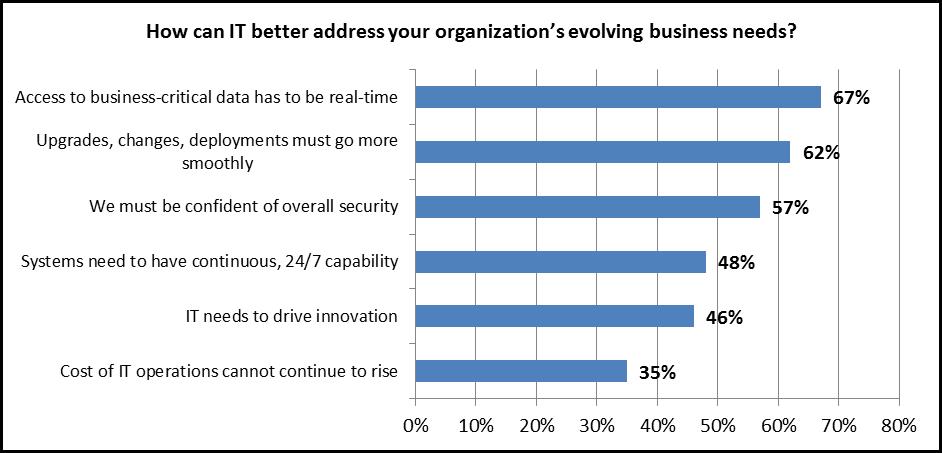 Technology has shifted from a business enabler to an integral component of business operations. As a result, a majority share of the technology budget has moved to business buyers (functional and Lines of Business (LOB) heads). These business buyers look for solutions that prioritize business concerns and simplify technology environments.[i]
Technology has shifted from a business enabler to an integral component of business operations. As a result, a majority share of the technology budget has moved to business buyers (functional and Lines of Business (LOB) heads). These business buyers look for solutions that prioritize business concerns and simplify technology environments.[i]
For marketers, developing commercial insights, getting to know the needs and motivations of different types of business buyers is a new and essential challenge. As a result, we see growing interest in using prospect surveys to develop an in depth understanding of the needs of target prospects. In addition, they then use the summary reports from the results of the surveys as key components of targeted content marketing campaigns. In this blog, we summarize the results of a Gatepoint Rsearch survey of integrated system buyers. The survey was sponsored by Oracle and is a key part of their marketing strategy.
In May 2014, Gatepoint Research invited selected business development, sales, finance, and IT executives to participate in a survey themed Strategies for Maximizing Application Performance. Survey responders represent the financial services, healthcare, retail trade, telecom services, and utility industries. Of the organizations represented, 76% have annual revenues of greater than $1.5 billion. Management levels of the responders are predominantly senior decision makers: 25% hold the title CxO or VP and 71% are Directors.
Integrated systems: cost-effectively meeting business needs
According to the survey results, responders with a preference overwhelmingly chose an integrated, single-sourced stack that is engineered and certified together (57%) over disparate, best-of-breed hardware/software components (10%).
The top reasons respondents prefer an integrated system over best-of-breed are: “staff familiarity,” “single point of support and contact,” and “common components reduce risk and support.” However, underlying all of these aspects is the implicit notion of cost/benefit and bottom-line impacts.
Getting components from multiple vendors to work together is hard, expensive work – and continues across the useful lifetime of the system. With vendor-integrated systems, the vendor – not the buyer – assumes responsibility for the integration of a multitude of components across the system’s lifetime. The buyer gives up some flexibility in choosing the system’s components in exchange for lower total cost of ownership (TCO), and often more-capable systems, optimized to work together.
Vendor-integrated systems combine servers, storage, systems software, and common applications into a single engineered stack to simplify start-up and ongoing system management. The vendor optimizes the whole rather than any single part, and pays attention to critical system qualities including usability, performance, interoperability, security, manageability, and the ability to evolve – all priorities identified in Gatepoint’s survey. As a Forrester report states, “The combined benefits of [engineered systems] are greater than the sum of the parts.”[ii]
As to which system qualities survey respondents deem most important, the graphic below (figure 1) identifies priorities regarding how IT can better address its organization’s evolving business needs. The respondents’ top three priorities are:
- Performance (real-time access to business-critical data)
- Adaptability (smoother updates, changes, and deployments)
- Security (confidence in overall security)

© Gatepoint Research 2014 |
Figure 1
Maximizing business value – integrated without compromise
For business buyers wanting to effectively shift the business-led buying of technology capabilities toward more vendor-integrated solutions addressing key concerns, compromises are no longer required. Buyers no longer have to choose between an integrated system and best-of-breed – today’s top vendors have already sourced, integrated, and tested options to provide a fully optimized system. Yet the adherence to open standards means that adaptability is fully preserved – the capability exists, should the need arise, to add new applications. Moreover, this ability to customize and add applications cost-effectively translates to less risk and more bottom-line savings, while minimizing the need to adapt custom capabilities. With vendor-integrated systems, business buyers can rest assured that their business needs will continue to be met throughout the life of their system as vendors proactively manage interoperability and performance, as well as security issues and updates.
In today’s 24/7 digital business context, IT has a critical role to play in addressing rapidly evolving business challenges. Vendor-integrated systems enhance the organization’s ability to adapt and flex responsively, while empowering better, faster decision making for a competitive edge. Maximized performance and minimized downtime result in streamlined operations and improved end-user/client services – all of which translates to more effective teams, happier clients, and significant bottom-line improvements.
To learn more about meeting the needs and priorities of business buyers, read the full white paper, Integrated IT Solutions Support Business Priorities, published by SimplyDIRECT’s subsidiary, Gatepoint Research.
To Find out more about how SimplyDIRECT prospect surveys can help your business, click here.
[i] 2013 Buyer Experience Survey, IDC 2013
[ii] The Total Economic Impact of Oracle Exadata and Oracle Exalogic, Forrester, Sept. 2013
